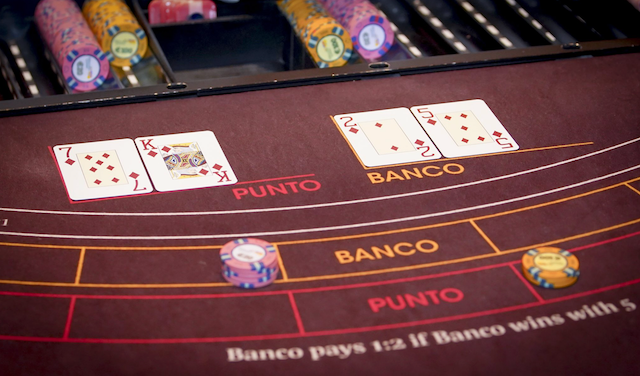Chemin de Fer, Baccarat or Punto Banco? What is the difference?
 Here at Gaming Support we think we know everything, however as it turns out, we hate to say it, but sometimes we get it all wrong...or at least we have to nuance our opinion. Until last week I have had heard the terms Chemin de Fer, Baccarat and Punto Banco and conveniently had swept them all into the same section of my brain-cells without further thinking about it. Until we had an internal discussion on Baccarat and Punto Banco.
Here at Gaming Support we think we know everything, however as it turns out, we hate to say it, but sometimes we get it all wrong...or at least we have to nuance our opinion. Until last week I have had heard the terms Chemin de Fer, Baccarat and Punto Banco and conveniently had swept them all into the same section of my brain-cells without further thinking about it. Until we had an internal discussion on Baccarat and Punto Banco.
Here’s what we found out for you:
Chemin de fer a.k.a. “Shimmy”, “Chemmy” or “Chernay” (Since 1891)
Card game in which two hands are dealt, any number of players may bet against the dealer, and the winning hand is the one that comes closer to but does not exceed a count of nine on two or three cards. The game is played by up to 12 players, on a kidney-shaped table; the object is to total 9 with a hand of two or three cards. When the cards total a two-digit number, the first digit is ignored, so that 14 would count as 4. Ace counts as 1, number cards at face value, and picture cards as 10 (which counts 0). Chemin de fer derives from the Italian game baccarat, differing from it in that players bet one at a time against each other instead of against the house.
If during game play neither the banker nor the player has an 8 or 9, the player now has a choice to make. Unlike in other versions of Baccarat, the player can choose whether or not to take the 3rd card.
However, there are rules which should be adhered to in the game as you act for a number of other players as well, and detouring from it can be frowned upon if you lose.
The Players Rule
|
Total |
Player action |
|
0 to 4 |
Draw a card |
|
5 |
Draw or stand |
|
6 or 7 |
Stand |
|
8 or 9 |
Hand over before 3rd card taken |
Only really when a player has a total of 5 do they get to choose whether or not to draw a 3rd card, it is down to the player in charge of the hand to make this decision. If the player draws a 3rd card, it is dealt face up so the banker can also see the extra card.
Although the banker has the decision as to whether to take a 3rd card, there is also a general consensus as to what they should do with only 2 cases of the banker deciding what to do.
The table below gives further information on this:
|
Banker total |
Banker Draws |
Banker Stands |
Up to Banker |
|
0 to 2 |
Always Draws |
Never |
|
|
3 |
If player 3rd card is 1 to 7 or 10 |
If player 3rd card is 8 |
If player 3rd card is 9 |
|
4 |
If player 3rd card is 2 to 7 |
If player 3rd card is 0,1,8 or 9 |
|
|
5 |
If player 3rd card is 5 to 7 |
If player 3rd card is 0,1,2,3,8 or 9 |
If player 3rd card is 4 |
|
6 |
If player 3rd card is 6 or 7 |
If player 3rd card is 0 to 5 or 8 or 9 |
|
|
7 |
Never |
Always Stands |
|
|
8 or 9 |
No 3rd card drawn |
No 3rd card drawn |
|
If the Player stands, the Banker should draw a 3rd card with a total of 0 to 5 and stand on 6 or 7. Once all cards have been dealt, both hands are turned over and winnings paid. If the player has a higher total, all players whose bets were accepted are paid out at 1 to 1 from the funds set aside by the banker.
If the banker has the higher hand, the banker wins all the player bets less 5% which is paid to the casino.
In the event of a tie, the bets are left on the table and paid out the following hand when either the player or banker wins.
As you can see, being the banker means you can potentially win a higher amount than when you are a player, however, you do risk more in this position too as you are potentially betting against several players at any one time.
Once a hand has finished, the banker has the chance to remain as the banker for the next hand. They will need to risk more funds in order to do this or pass it on to the next player. It is considered bad practice in Chemin De Fer and French Baccarat to give up the banker position if you win after the 1st hand, players should have at least one opportunity to win their money back. If the banker wins 3 or 4 times in a row, it is acceptable for them to allow the next player to replace them as the banker.

Baccarat or Baccara
Casino play involves three or six 52-card decks shuffled together and dealt from a dealing box called a “shoe.” Players aim for a total count of nine, or as close as they can get, in a hand of two or three cards. Face (court) cards and 10s are counted as zero; all others take their index value. The cards in each hand are added to obtain the value, but only the last digit is significant. Thus, if the two cards in a hand are 8 and 5, the count is not 13 but 3. A competing hand with a face card (zero) and a 6 wins because it is closer to a count of nine.
In basic baccarat the house is the bank. In the related game chemin de fer, the bank passes from player to player.
Punto Banco
Punto Banco is known as North-American Baccarat or Straight Punto Banco.
Punto Banco is the simplified / standardised version of Baccarat. In Punto Banco the Bank appears to pass from player to player but is actually held by the house. Punto Banco is played with six to eight decks.
The casino is designated as the banker while the highest bidder is considered the player. Players also have the option of betting on a tie between the banker and the player. The cards are first dealt face-down. They are then turned over, and the caller counts the points secured by each player. If any player gets 8 or 9 points in the first round, they are declared the winner, and no more cards are dealt. A player who gets between 0 and 5 points is allowed another hit. If a player gets anything above that range, then they are required to stand.
The differences between the versions of baccarat lined up:
- The number of Card Decks used.
- Terminology for Banker , Player and Tie differs.
- The rules of the development of the game that decide which hand wins, are the same in every version.
- Punto Banco is the most simplified version of baccarat, which is why it is played most.
- In Punto Banco every player can bet on Banker, Tie or Player. At Chemin de fer and Baccarat Banque, the player will always play with the hand of the ‘player’.
- At Chemin de fer the banker will change most, namely every time a banker loses his hand.
- In Baccarat Banque the banker will play against two hands.
- Punto banco has standardized rules, which are similar almost everywhere, while the other versions can differ in each casino.
Sources:
https://www.merriam-webster.com/dictionary/chemin%20de%20fer
https://www.britannica.com/topic/chemin-de-fer
https://www.britannica.com/topic/baccarat-card-game
https://www.casinoencyclopedia.com/punto-banco-baccarat/

